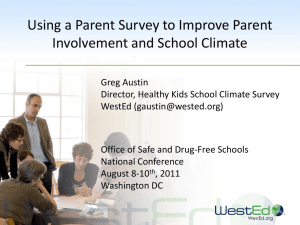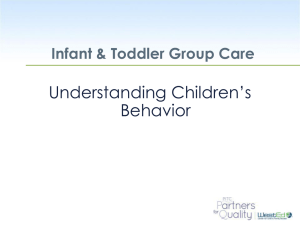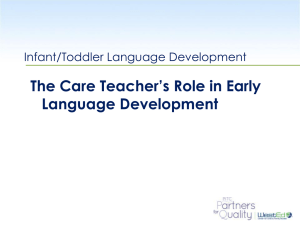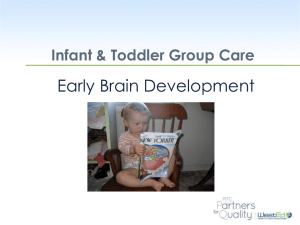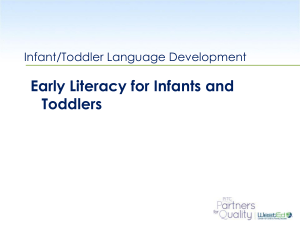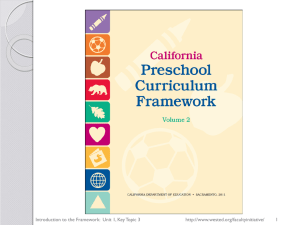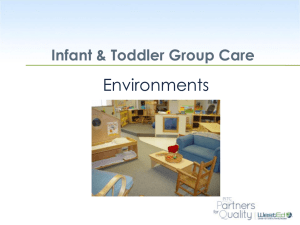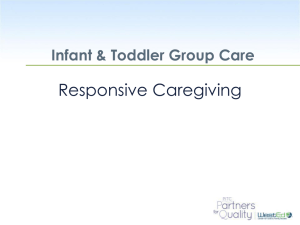The Special Education Supports Information System (SESIS)
advertisement
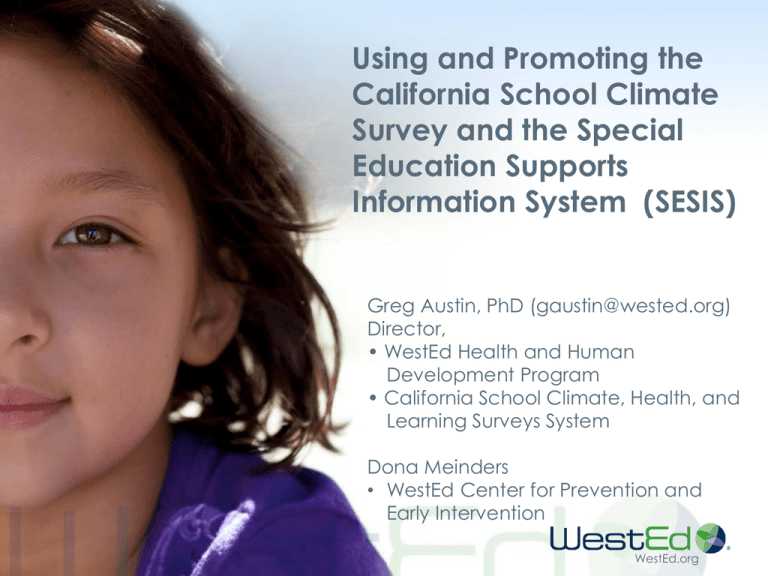
Using and Promoting the California School Climate Survey and the Special Education Supports Information System (SESIS) Greg Austin, PhD (gaustin@wested.org) Director, • WestEd Health and Human Development Program • California School Climate, Health, and Learning Surveys System Dona Meinders • WestEd Center for Prevention and Early Intervention WestEd.org Presentation Outline • Data and resources available through the California School Climate Survey (CSCS) of school staff and its Special Education Supports Information System (SESIS). • Why school climate matters to special education. • Example of data use • Key state findings. • Current challenges to sustaining the system and how to address. WHAT YOU NEED TO KNOW TO USE AND PROMOTE! WestEd.org 2 What is SESIS? • Part of the California School Climate Survey (CSCS) data system. • A resource that provides schools, districts, SELPAs, and CDE with data from school staff to better: Understand and address the needs of students and staff in special education programs. Improve staff working conditions and retention. Integrate special and general education • Development funded by CDE Division of Special Education and the California Comprehensive Center, 2008-12. WestEd.org 3 Key SESIS Components • Addition of questions to CSCS to identify special education (SE) teachers and other service providers CSCS. • Addition of Special Education Supports Module. • Reports comparing results from Special Education providers vs. others. • Website: cscs.wested.org/about/projects/sesis. WestEd.org 4 What is the California School Climate Survey (CSCS)? • The state’s main survey of and about school staff. • One of the three linked tools for local data collection that form the California School Climate, Health, and Learning Survey System (Cal-SCHLS): CA Healthy Kids Survey (CHKS) CA School Climate Survey (CSCS) CA School Parent Survey (CSPS) • A project of the California Dept of Ed, with support from the Dept of Alcohol and Drug Programs. • Websites: cal-schls/chks/cscs/csps.wested.org WestEd.org 5 What is Cal-SCHLS? • The largest, oldest effort to provide schools/communities statewide with local data from students, staff, parents to: Identify the needs of students of students related to success in school, career, and life. Promote health and well-being. Improve school climates, teacher satisfaction and retention, and parent involvement • Identified as a model system by the US Dept of Ed (Successful, Safe, and Healthy Students) WestEd.org 6 California School Climate Survey (CSCS): Development • Main Goals Assess needs of teachers and other staff in light of teacher retention issue. • Influenced by research on factors that influence teachers staying or leaving the field and overall job satisfaction (e.g., Futernick, 2007*) Provide staff perceptions to compare with student self-report in CHKS. Provide data on supports and services provided for students and staff, general and special education. • Developed collaboratively by: WestEd Cal-SCHLS staff & California Comprehensive Center CDE Coordinated School Health and Safety Office, Special Education Division, Superintendent’s P16 Office *Ken Futernick, A Possible Dream….Retaining California Teachers…So ALL Children Can Learn (2007) WestEd.org 7 CSCS Overview • Modular instrument (download: cscs.wested.org) General Core (for all staff) Learning Supports Module (health/prevention staff) Special Education Supports Module • For providers of services to students with Individualized Education Programs (IEPs) Custom Module (You can add questions!) • On-line and no cost if administered with CHKS • All certified and classified staff, elementary through high school Anonymous and voluntary • 2004-10 required biennially of all LEAs receiving NCLB Title IV funding. Typically administered by about: 700 Districts, 4,800 Schools, 94,000 Staff WestEd.org 8 Core Module Content (43 items/all staff ) Respondent demographics and rolls Academic priorities, norms & standards Student motivation & readiness to learn Relationships: student/staff & intra-staff (collegiality) Staff supports, involvement in decision-making, & professional development needs Student & staff safety Impact on school of student behavior • Perceived student physical and mental health Equity & discipline (communication & enforcement) Parent involvement WestEd.org 9 SE-related Content • Respondent role in school (Core): Special education teacher (#1) Provide services to students in special education (#2) • Need for professional development in serving SE students (Core). • School SE supports: Provides materials, resources, and training needed to work with IEP students (Core). Provides services for students with disabilities/special needs (Learning Supports Module). Emphasizes helping students with their social, emotional, and behavioral problems (Learning Supports Module). WestEd.org 10 Content: Special Education Supports Module (SESM) • Staff degrees, credentials, service setting • Bureaucratic barriers (3 items) • Integration & collaboration between special & general ed (5 items) • Expectations & supports for students with IEPs (5 items) • Staff personnel supports (7 items) Influenced by Futernick (2007)* research on factors affecting staff retention * See slide 7 WestEd.org 11 Reports (2008-12 at cscs.wested.org) • 670 District Main Reports with SESM (biennial) Some received two (biennial) • District SE Reports Disaggregated by SE staff providers vs. all others • Minimum 5 staff respondents to preserve confidentiality 2008-10: 493 reports 2010-12: 253 reports (Lower due to declining CSCS participation) • 58 SELPA Main Reports 1- or 2-year aggregations, 2009-11, total sample Excluding single district SELPAs • 2 State Reports (2008-10) SE Providers vs. Other Staff SE vs. General Ed Teacher WestEd.org 12 SESM Summary Table from Main Report WestEd.org 13 Sample Page from SE Report WestEd.org 14 Other Data Availability • School-level reports and full datasets on request • Custom disaggregations • Query CSCS Forthcoming online access to total sample results. WestEd.org 15 Resources • CSCS Survey Content Guide Describes purpose and significance of each question on survey, including SESM • Making Sense of School Climate: Using Cal-SCHLS to Inform Your School Improvement Efforts (californiaS3.wested.org/tools) • Making Data-driven Decisions in Student Support and School Mental Health Programs: A Guidebook for Practice (forthcoming) • CHKS Guidebook for Data Use and Dissemination • Data Use and Student Voice Workshops WestEd.org 16 School Climate Data Workbook • Worksheets for identifying and understanding key survey results, including Special Education related. • Action guide to next steps in using CHKS/CSCS data to improve practice and policy in improving school climate, closing the achievement gap, and meeting the needs of diverse populations. (californiaS3.wested.org/tools) WestEd.org 17 WestEd.org Generic Question Worksheets WestEd.org Why School Climate Matters WestEd.org School Climate: What is It? • The learning conditions and quality of the school environment that affect the attitudes, behaviors, and performance of both students and staff. Acts as a filter to a student’s potential to succeed — can impede or enhance. • Strongest argument you can make for why CSCS data needed by the school. • An approach to school improvement that aligns with many concepts found in special education. WestEd.org 21 Why Is It Important? • “… to a greater or less extent, all research on school climate finds a positive correlation between better school climate and increased student learning and achievement.” – Jones et al. 2008 Attendance, behavior, grades, test scores, and graduation • School climate directly influences the psychosocial as well as cognitive development of students . • Indirectly influences achievement through its effect on teacher performance and retention (job satisfaction). WestEd.org 22 Importance: Staff Retention Teaching and learning conditions are key factor influencing retention in the teaching profession (Futernick 2007)* • This is especially true for special educators School climate factors are among the most important in whether teachers stay or leave. • Relationships and collegiality. • Opportunities for participation and decision making, control over the workload. • Perceptions about system & administrative support. SESM designed to fit under these research categories *See slide 6 WestEd.org 23 The Missing Piece in School Reform • School climate is “possibly the least discussed element in practical conversations about how to improve student achievement.” (Jerald 2006) • Only 10-20% of school turnaround efforts succeed. • Most school reform efforts focused on improvements in instruction and governance. Often necessary but insufficient. Fall short when lack attention to why students learn and how the school environment affects them. • The greatest teachers and instruction will have little impact if students do not attend, behave, and try — and climate influences all of these. WestEd.org 24 Importance of the School Climate Focus • Directs attention to the supports and opportunities schools provide to ensure all student succeed. • Rooted in recognition school success requires addressing the needs of the Whole Child — Social, Emotional, Physical, as well as Cognitive WestEd.org 25 Focus Aligns with Response-to-Intervention Approaches • Identify school-wide issues that can be addressed by fostering protective factors that impact multiple risk factors and problem behaviors, and promote positive development. • Early identification of at-risk groups. • Implementing interventions for high-risk youth. Intense, Individualized Interventions 1-5% Targeted Group Interventions 5-10% Universal Interventions 80-90% WestEd.org 26 Examples of SESIS Data Use WestEd.org Topics Included in CSCS Reports 1. Learning and Working Environment 2. Student Developmental Supports and Opportunities 3. Respect, Cultural Sensitivity, and the Achievement Gap 4. Learning Readiness and Engagement Indicators 5. Perceived Student Risk Behavior 6. Discipline & Counseling 7. Learning Supports Module: 8. Student Services and Policies Special Education Supports Module: Barriers to Effective Service Delivery Integration and Collaboration between Special and General Education Expectations and Supports for Special Populations Personnel Supports WestEd.org 28 Possible Uses of the Data District-level* data that can be used for: • Identification of Root Causes of Disproportionate Representation • Data for district improvement plans for Program Improvement • Improvement of special education services • LEA Plan Development • Retention of special education teachers *School level may be available on request WestEd.org 29 California School Climate Survey Main District Report 2010-11 Total Respondents 360 Role of Respondents •General Education Teachers 80% •Special Education teachers 10% •Administrators 2% •Other (Counselors, classified staff, psychologists) 8% Length of Time at Current Site •Over 10 years 40% •6-10 years 25% •3-5 years 23% •0-2 years 11% WestEd.org CSCS District Data 2010-11 Findings Related to Statements of Need Percent Disagreeing or Strongly Disagreeing Total District This school has staff examine their own cultural biases through professional development or other processes 54% This school has sufficient resources to create a safe campus This school provides materials, resources and training needed to work with special education students Provides sufficient time to collaborate on service delivery 51% 44% 9% WestEd.org CSCS District Data 2010-11 Findings Related to the Severity of Student Problems Respondents rated the following problems as moderate or severe: Percent Disruptive student behavior 67 Vandalism 51 Student alcohol or drug use 51 Gang related activities 48 Lack of respect of staff by students 47 Harassment or bullying among students 42 WestEd.org CSCS District Data 2010-11 Findings Related to Professional Development Needs Perceived Need for Additional Professional Development Percent Responding Yes Meeting the social, emotional, and developmental needs of youth 64 Closing the achievement gap 61 Working with special education students 57 Creating a positive school climate 56 Culturally relevant pedagogy 55 Serving English language learners 51 Positive behavior supports and classroom management 50 WestEd.org STATEWIDE RESULTS (2008-10): Confirm survey need and value for Special Education WestEd.org Respondents (2008-10 Report) CORE MODULE • Total 94,000 • SE Providers 65,000 (c.2000 per school level; highest elementary) • SE Teachers 7,200 • 670 districts & 4,844 schools SESM • Total 60,400 • SE Providers 45,000 • SE Teachers 6,500 (other teachers 43,600) WestEd.org 35 Key Results: Core and Learning Supports Module • Elementary staff higher than high school for: Level of resources provided to SE, Help provided for students with social-emotional problems, and PD need in serving SE students. • High school staff higher than elementary for: Student depression/mental health being moderate/severe problem at school Providing services for students with disabilities/special needs WestEd.org 36 Key Results: Special Ed vs. General Ed (Core Items) • SE vs. GE differences greater among teachers than providers (for which often small). • SE teachers less positive than GE on school climate indicators. • SE more positive on SE-related items. • Overall results mask school-level differences Less positive results for SE vs. GE teachers largely found in high schools, followed by middle schools. Elementary differences small, or SE more positive than GE. WestEd.org 37 SE Teachers Less Positive than GE for School Climate Indicators (Strongly Agree) • Students equal opportunity for classroom participation. (<8 points, 34% SE vs. 42% GE) • Staff really care about every student. (<5 points, 41% SE vs. 46% GE) • Staff treat every students with respect. (<5 points, 34% SE vs. 39% GE) • School supportive and inviting place to learn. (<4 points, 41% SE vs. 45% GE) • School promotes academic success for all students. (<4 points, 40% SE vs. 44% GE) • School provides materials, resources, training to do job effectively. (<3 points, 22% SE vs. GE 25%) SE = Special Ed Teachers; GE = General Ed Teacher WestEd.org 38 Professional Development Needs (SE vs. GE Teachers) • Overall little difference Including for serving special education students (48% vs. 50%) • Biggest differences: Meeting social, emotional, developmental needs of students, (>5 points, 56% vs. 51%) Positive behavior supports & classroom management (>6 points, 45% vs. 39%) WestEd.org 39 Sustaining the Data WestEd.org Challenges to Data Availability • NCLB Title 4 defunding has ended CDE survey requirement and source of covering survey costs Over one-third decline in survey participation in 2011-12 • Less willing to do anything that not required, costs money and labor (biggest issue), and involves classroom time If schools stop surveying, lose not only local data but ability to aggregate at county, SELPA, and state levels. • Lost $250,000 project support WestEd.org 41 Challenges to Data Availability: SESIS • CDE no longer funding SESIS and preparation of Special Ed Reports (disaggregated by providers) Under review: SESM to be converted to supplementary module, only added on request (with fee of $100) Disaggregated reports (SE providers vs. others) provided only on request • $100 preparation fee. WestEd.org 42 Responses: State and County Supports for CHKS/CSCS • Online CHKS to reduce survey administration labor • CHKS/CSCS still required of state TUPE (Tobacco Use Prevention Education) grantees New Tier 1 grants specifically to fund survey • County agencies collaborating to provide funding to preserve countywide district administration Orange, Sonoma etc. • County AOD depts can use Substance Abuse Prevention & Treatment (SAPT) Block Grant Primary Prevention funds to support survey • State funding for CHKS support if agree to participate in state substance use survey (CSS) • Most supports for CHKS, but CSCS free with it WestEd.org 43 What You Can Do: Actively Lobby for Survey Participation • Reach out to all stakeholders (health, prevention, school improvement team, administrators). Show how data meets multiple needs (break down silos). • Make the case for the survey’s value to the school, both for Special Ed and school improvement efforts in general. Speak to the school’s concerns. Improving student attendance, engagement, grades, and graduation Addressing teacher retention and parent/community involvement. • Local data essential for guiding school and program improvement efforts as part of a data-driven decisionmaking process. See Cal-SCHLS Guidelines for Survey Administration, 2010-11. (www.cal-schls.wested.org) WestEd.org 44 What You Can Do • Offer to help plan and administer the survey Make sure SESM added to the CSCS. Make sure disaggregated Special Ed Report requested. • Work to find sources of funding Network with county agencies for countywide support Local foundations and other data users Have district apply for TUPE grant • Show them examples from existing CSCS/CHKS data for why important. • Provide expertise to help students in need. See: CHKS Guidebook to Data Use and Dissemination WestEd.org 45 Survey Value: Other Ways It Has Been Used • Obtaining program funding – Federal/state grants will still be requiring needsassessment data to justify funding in proposals. – One of the primary benefits cited by LEAs – Required to obtain State TUPE grants. • Identifying youth needs, especially most vulnerable populations • Raising public awareness and school support • Improving school-community collaboration in meeting needs of youth See Cal-SCHLS Guidelines for Survey Administration, 201011. (www.cal-schls.wested.org) WestEd.org 46 Value: Cost Benefit • Direct costs low: CHKS/CSCS only $.30/kid. – For half of districts, basic fees c.$130 or less. – Districts in 6th & 7th deciles, from $150-350. – The 10% of largest districts, $1,000. – Cost effective means to collect other needed data (add questions) • Don’t have to do the CHKS. Stand-alone costs: $250-500 depending on district size • Real need help in labor costs (planning & administering the survey) See Cal-SCHLS Guidelines for Survey Administration, 201011. (www.cal-schls.wested.org) WestEd.org 47 For further information: • Gregory Austin, CHKS/CSCS Director gaustin@wested.org 562.799.5155 Website: www.wested.org/cscs • Toll-free CHKS/CSCS Information Line: 888.841.7536 • Janet Digmon, California Department of Education jdigmon@cde.ca.gov WestEd.org 48
